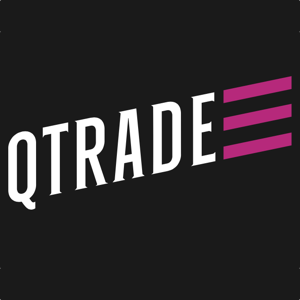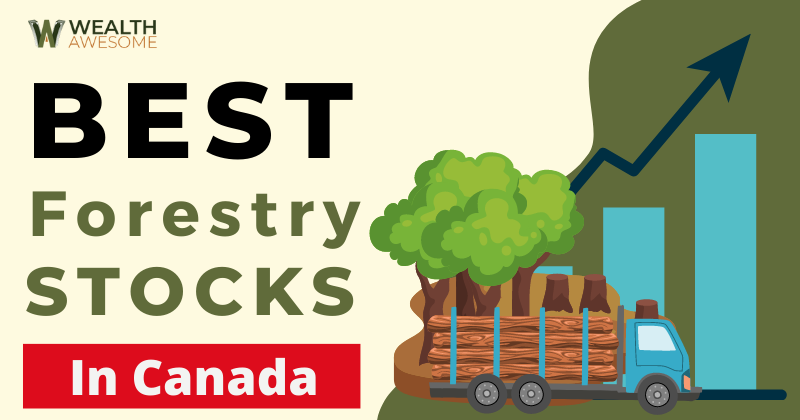About 90% of homes in America are built with wood. It’s a stark contrast to most other countries in the world.
In Europe, only about 7% of the total housing stock comprised of wood by about 2006. However, the trend there is changing, and most of the new constructions (about 80%) of the new constructions in Europe are now made up of wood.
As one of the largest exporters of lumber and various forestry products, Canada is set to take advantage of this change.
As wood becomes the new sustainable favourite construction element around the globe, the best forestry stocks in Canada might see positive long-term momentum as well.
Canadian Forestry Stocks – Are They Worth Investing In?
The four most significant forest products are, in order:
- Roundwood – Raw material timber left in round logs
- Sawn wood – Lumber that has been mechanically sawn (lengthwise)
- Paper and paperboard – Made from specific tree types, mainly spruce and pine
- Wood-based panels – A variety of wooden board products
Canada was the second-largest exporter in three of these product categories in 2020: Sawnwood, panels, and pulp for paper.
So Canada is one of the top global exporters of forestry products, and the reach of Canadian forestry businesses is quite extensive.
And as long as there is enough demand for these products, these businesses are likely to stay profitable.
We are seeing a massive shift in European construction as they now prefer wood over concrete for sustainable construction, and this trend will likely spread far and wide as the world as a whole world moves closer to net zero by 2050.
The only caveat here is the tipping point between sustainable harvesting of wood with increased usage.
The forests these woods come from are responsible for about 28% of the oxygen in the atmosphere, and too much extraction can tip the scales against humanity’s favour.
Ironically, this can actually help the best forestry stocks in Canada because as lumbar demand goes up and supply remains relatively limited, the prices and profits can go right through the roof.
Best Forestry Stocks In Canada
As one of the largest forestry product exporters in the world, Canada has a healthy collection of forestry stocks.
1. West Fraser Stock

- Ticker: WFG.TO
- Specialty: Lumber and Oriented Strand Board
- Forward Dividend Yield: 1.34%
- Dividend Payout Ratio: 3.78%
- Dividend Yield (12-Month Trailing): 1.13%
- Upcoming Dividend Date: Jan 15, 2024
- Market Cap: $8.72 Billion
- Forward P/E Ratio: 22.15
West Fraser is the forestry giant, and not just in Canada. It has a massive production footprint with 33 lumber mills, 13 OSB plants (which is a special type of wood panel), and six renewable energy facilities (among several others).
These facilities span two continents. Note that the company doesn’t own or operate any forest land; its focus is forestry products.
However, the company has planted about 2 billion trees by now. The bulk of its facilities is in North America, and the rest are in Europe.
If you disregard the massive dips and periods of stagnation, West Fraser has been a good growth stock in the last decade, with a powerful ten-year CAGR (Feb 2012 to Feb 2022) of 19.7%.
If the company can sustain this pace for the next one or two decades, it can be a worthwhile holding. It pays dividends as well, but the yield is usually quite low.
2. Canfor Stock

- Ticker: CFP.TO
- Specialty: Lumber and Pulp & Paper
- Forward Dividend Yield: N/A
- Market Cap: $1.80 Billion
- Forward P/E Ratio: -27.4
Canfor actually has two separate divisions, one dedicated to lumber and the other to pulp.
The pulp one is an independent publicly traded company with a different ticker (CFX). However, performance-wise, CFP might be the better option.
Under its lumber business division, the company has three major products to its name – Three different types of wood classes for three markets.
The company has an impressive global footprint with facilities and offices in multiple countries.
The pulp business also integrates into the company’s recycling policy, as the company tries to use about 100% of its wood fibres. It also produces bioenergy and about 910 MWh of power.
Canfor stock doesn’t offer dividends or linear growth. But its capital appreciation potential should not be disregarded.
Since 2009, it has gone through three growth bouts, growing (from dip to peak) by about 500%, 150%, and 400%, respectively.
3. Stella-Jones Stock

- Ticker: SJ.TO
- Specialty: Pressure-Treated Wood Products
- Forward Dividend Yield: 2.12%
- Dividend Payout Ratio: 21.96%
- Dividend Yield (12-Month Trailing): 1.11%
- Upcoming Dividend Date: Dec 21, 2023
- Market Cap: $4.60 Billion
- Forward P/E Ratio: 14.05
Stella-Jones has about 40 facilities, 13 in Canada and the rest in the US. It also has an extensive network of distribution facilities.
The pressured wood products the company makes are used in various ways; however, in 2020, the three most significant sales avenues were utility poles, railway ties, and residential lumber.
Stella-Jones has the distinction of being the only dividend aristocrat in the forestry market segment, and it has been growing its payouts for 16 consecutive years.
However, the yield is not too attractive.
4. Interfor Stock

- Ticker: IFP.TO
- Specialty: Pure-Play Lumber Company
- Forward Dividend Yield: N/A
- Market Cap: $990.33 Million
- Forward P/E Ratio: 8.02
Interfor is perhaps the only pure-play lumber company in the Canadian forestry industry. Most other companies have at least one other market segment.
The company considers this undiversified approach a strength, which allows them to excel in one thing only.
It’s among the top five producers in the country (by capacity, which is about 3.9 billion board feet a year), and more than half of it is concentrated in the US South, which makes sense considering about 88% of the company’s sales also happen in the US.
Interfor is a relatively younger stock and started trading in 2014. Since its inception, it has gone through just two considerable growth phases: Once was when it grew about 180% between Oct 2015 and May 2018, and the other was when it rose almost 660% between March 2020 and Jan 2022.
It doesn’t pay dividends but gave out a very generous special one in 2021.
5. Western Forest Products Stock

- Ticker: WEF.TO
- Specialty: Sawnwood and specialty lumber
- Forward Dividend Yield: 3.33%
- Dividend Payout Ratio: 9.66%
- Dividend Yield (12-Month Trailing): 7.69%
- Upcoming Dividend Date: Sep 15, 2023
- Market Cap: $199.55 Million
- Forward P/E Ratio: -7
Western Forest Products has access to about 6 million cubic meters in an allowable annual cut in BC timberlands.
Its 1 billion board feet annual capacity might be lower than other giants on this list, but it’s pretty impressive. It also has four remanufacturing facilities (to work on lumber that has already gone through the mill).
The bulk of the company’s revenue comes from specialty lumber. Geographically, though US and Canada make up the most significant market segments, it also has a healthy international market.
The stock comes with a decent dividend yield and powerful but cyclical growth potential.
If someone had bought the company in 2010, they could have grown your capital 10x by Feb 2014.
6. Acadian Timber Stock

- Ticker: ADN.TO
- Specialty: Timberland
- Forward Dividend Yield: 6.88%
- Dividend Payout Ratio: 124.73%
- Dividend Yield (12-Month Trailing): 6.9%
- Upcoming Dividend Date: Jan 15, 2024
- Market Cap: $287.12 Million
- Forward P/E Ratio: 16.64
Acadian Timber is the first genuine timberland stock on this list. The company holds (owns and manages) about 1.1 million acres of their own timberlands in New Brunswick and Maines.
It also provides services for another 1.3 million acres in NB. The bulk of the company’s product portfolio is made up of solid wood; the rest is tissue, pulp, fuelwood, and engineered wood.
This renewable resource puts the company in an interesting position and allows it to remain financially healthy, as long as there is demand for the variety of forestry products that can be made with its hardwood and softwood.
Honourable Mentions
Cascades is another giant that is technically a part of the forestry industry, but its main focus is packaging products that are made up of recycled wood fibre. The company has almost 80 units and employs 10,000 people.
Its forestry connection is the raw material for its products (Tissues, fibre-based materials, and packaging solutions). It has been a cyclical growth stock so far.
Goodfellows is a micro-cap company that offers finished forestry products like decking, flooring, siding, panels, etc. The stack has been chiefly an inconsistent grower.
Conifex Timber is another micro-cap logging company that, due to its drastic fall from its glory days valuation, offers powerful spiking/growth potential in the right market conditions but little to no stability.
Which Is The Largest Lumber Company In Canada?
West Fraser is the largest lumber company in Canada by production capacity (of sawn wood). It’s also the biggest lumber producer in the world and the biggest forestry stock by market cap (by a significant margin).
How To Buy Forestry Stocks In Canada
The cheapest way to buy stocks is from discount brokers. My top choices in Canada are:

- 105 commission-free ETFs to buy and sell
- Excellent customer service
- Top-notch market research tools
- Easy-to-use and stable platform

- Stock and ETF buys and sells have $0 trading fees
- Desktop and mobile trading
- Reputable fintech company
- Fractional shares available
To learn more, check out my full breakdown of the best trading platforms in Canada here.
Conclusion

Even Canada’s best and most powerful forestry stocks don’t offer reliable and consistent growth potential.
But the cyclical growth and dividends might be enough reason to consider adding this asset class to your portfolio.
The demand for lumber is likely to increase in the future, and since resource revitalization takes years, supply constraints might become quite common.
This is the most natural catalyst that might boost these companies to very desirable heights.
So consider buying them low and wait for the right market conditions. If forestry stocks are not your idea of ESG investing, there are some other ESG stocks that you might like.




